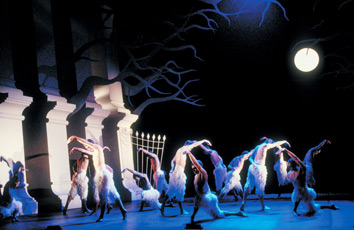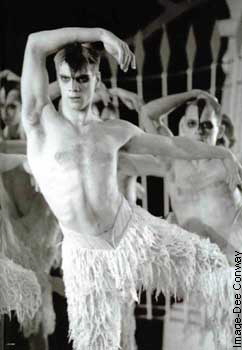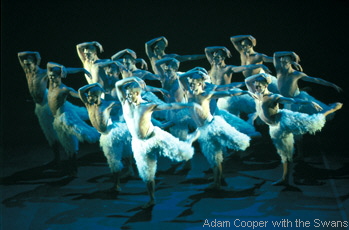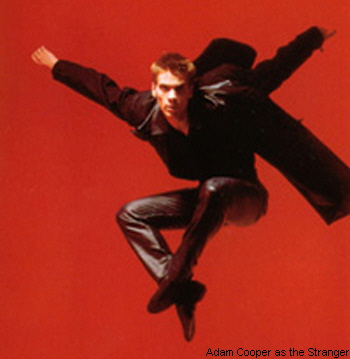|
If I look back at the most thrilling ballet experiences of the past 15 or so years, Matthew Bourne's 1995 Swan Lake is at the undisputed top. The very idea of replacing the point-shoe dainty swan-maidens by men gave me such a jolt, 10 years ago, that I instantly flew to LA to be at the first American opening of the show. Shortly thereafter, the New York opening was a perfect pretext to head east and see it a second time, and since then, I have watched it innumerable times on video, always with the original cast – the dream cast: Adam Cooper (of Royal Ballet fame) as the Swan and Bourne's partner and collaborator Scott Ambler as the Prince. Cooper was also seen at the end of the movie Billie Elliott in one of his mighty swan leaps onto the stage.
THE STORY
Bourne has updated the très 19th century romantic tale to the British Court in the stuffy early sixties. Instead of the Prince's birthday party where the Queen admonishes him that within a day he will have to choose a bride, Bourne's Prince is shown first as a little boy groomed and polished for the rituals of being his Queen Mother's companion. As a young man, he is bored to death by the repetitive ceremonies, and deadly embarrassed by his mother's promiscuity.
The original romantic Prince goes hunting at night and encounters the Swan Maidens who are under a sorcerer's spell but have permission to take back their human shape every night. He falls in love with their Queen, the White Swan (Odette), and promises to save her and her swan sisters from the curse through eternal love. In Bourne's modern version, the Prince's tutor arranges for a paid "Girlfriend" for the shy young man who has no close contacts and keeps dreaming about swans. In a moment of disillusion he wants to throw himself into the river and end his life – but the appearance of a magnificent man-swan stops him. The Prince falls in love with his Swan.
The original last act begins with the Prince's engagement party. The sorcerer appears with the Black Swan (Odile), a fake copy of Odette, and fools the Prince who swears eternal love to the wrong woman. He hurries back into the woods to ask the White Swan for forgiveness for his mistake. When he can't hold onto her in human form, he throws himself into the lake – thus proving his eternal love and redeeming the curse.
Bourne's Act III at first follows suit with the Queen's ball arranged for royal guests. An intriguing "Stranger" appears, clad in black leather. In front of the Prince who recognizes the Swan, the Stranger begins to seduce one woman after another – for the obvious enjoyment of the Queen. Tormented by the orgiastic spectacle of his mother making out with the Stranger, and unable to claim his love, the Prince aims a pistol at the couple. He is hospitalized and terrorized. Back in his royal bed, in a fever dream, he sees the swans invade his room. He is reunited with his Swan, but now the other swans start attacking their leader for his transgressive union with a human. Trying in vain to protect the Prince, the outcast Swan dies, and so does the Prince.
THE 10-YEAR ANNIVERSARY
The 10-year-anniversary tour of Bourne's London-based company "New Adventures" finally brought the work to San Francisco where I would have expected a très gay, sophisticated audience and sold-out performances. This proved not to be the case. Far from sold out, the show at the Orpheum Theater seemed to attract a mainly provincial audience who sometimes had difficulties knowing when to laugh – as if they had expected a Ballet Trockadero show of men in tutus or some other spoof of "Brokeback Lake." Of course, Bourne is too good a dramaturge not to provide comic relief between highly dramatic waves. The movement of his groups of swans rewrites – in surprising, sometimes serious and sometimes outright funny ways (the "Four Little Swans") – the original choreography of Marius Petipa. The famous crowd-pleasing first waltz of the night has the prim and proper Queen and Prince wave in hilarious three-quarter rhythm to the crowd below, but the dreamy Prince gets stuck, perhaps mesmerized by his own limp wrist. When the Royals attend a Ballet performance, the scene in the loge is a comical gem as the hired Girlfriend misbehaves in every conceivable lower-class way. Meanwhile, the ballet they are watching makes fun of the romantic theme of Swan Lake itself – the 19th century cursed, tragic women like the Sylphides, Giselle and her "Willies," – or the Swan Maidens. The tragic elves and butterfly creatures are danced by ballerinas with such ridiculous aplomb that I wondered if they weren't in fact danced (à la Trockadero) by men.

For the 10-year anniversary, Bourne has adjusted a few minor pleats in the frock, mostly accentuating the humorous stripes. (One silly, gratuitous dance number, the Spanish Dance, has been added to Act III.) In the role of the Girlfriend, Leigh Daniels resonated with the memory of inappropriate would-be-Royal Fergie. This time, however, the Girlfriend is a funnier, more likeable figure than Emily Piercy in the original cast. Saranne Curtin as the Queen was every inch as impeccably beautiful, powerfully cold, controlled and unabashedly slutty, as Fiona Chadwick, the original Queen.
In Bourne's complex societal and psychological drama, the Queen is the origin of a tense oedipal conflict. We see her flirting and making out with every man in uniform but showing herself disgusted by her lonely, dreamy, (all too feminine?) son. When this manipulated, muted, crushed young man encounters his very opposite in the powerful, free, dangerously beautiful Swan, he finds his own language and evolves into eloquence. At first haltingly and clumsily, he copies and learns the movements of the Swan which allows him to enter the mythical realm of transformation. Again and again whipped asunder by the alien power of what comes across as huge wings and a sharp beak, he is able to engage in a dialogue with the magical creature, an understanding made of chasing and joining and insisting with increasing ecstatic and tender intensity.
This breathtaking, erotically charged dialogue that fills the second act culminates in the most touching embrace one could imagine when the Swan lifts the Prince up and carries him like one would carry a lonely little boy back to bed after an upsetting dream. The love affair between man and Swan-man is a heart-stopping development, brilliantly choreographed. An echo of mythical tales like Leda and the Swan, its sexual undercurrent dismisses with one well-aimed wing stroke the whole sexless classical Swan Lake into a dusty museum of dainty porcelains.
THE DREAM CAST
Adam Cooper, it turns out, was the ideal incarnation of the Swan – an act that will remain hard if not impossible to follow, similar to what we know and imagine about Nijinsky's Faun with its animal-creature innocence and the power not of man but of nature. It takes something akin to Shamanic shape-changing for this kind of accomplishment. In the case of Adam Cooper, his beauty is that of a movie star. He has, in fact, the features of a faun, sly and arch, lascivious and taunting, seductive and extremely self-possessed. He is an exquisite dancer with a tall, well-built body with broad shoulders and very strong, but graceful arms. His powerful leaps and quick-silver twists and turns are caught in uncanny balances like a sudden caught breath. But this virile, dominant power is interwoven with sensuality, with shocking moments of swanlike yielding and surrender.
 |
Bourne's vision apparently came out of the simple observation of swans: "The idea of a male swan makes complete sense to me," he once explained in an interview, "the strength, the beauty, the enormous wingspan of these creatures suggests to me the musculature of a male dancer more readily than a ballerina in her white tutu." In Bourne's concept of Swan Lake there is no sorcerer's spell that – once released – would turn the swans back into men. His swans belong and stay in a realm of shamanic "in between," and the body language that the choreographer found for them is both human and bird-like, "masculine" and "feminine," aggressive and deceptively tender, pliable as a swan's neck.
The original Prince, Scott Ambler, ideally would be a little younger, but Ambler is a great actor-dancer, and his facial and physical expressions draw a gripping and convincing arc from extreme shyness and inhibition to the awakening of longing and the unfolding of his emotions. The subtlety of his work comes through in the fact that in the pas de deuxs with the Swan he always remains the somewhat more awkward partner – the mere human partner of a god-like creature – and he has extraordinary moments of reeling, almost fainting from the vertigo of this first erotic realization of his life.
The art and magic of this original couple have been lost ten years later.
THE NEW CAST
Alan Vincent and Spaniard José Tirado are alternating as the Swan. Both are excellent, but flawed dancers. Tirado impressed with his tall, athletic body, whipping his very long limbs past the Prince with dangerous speed and intensity. Once he had warmed up and nailed his balances, his Swan carried a hypnotic, ferocious otherworldliness, but he was not able to modulate his Swan into more tender or seductive moods. He remained the same throughout, his White Swan as threatening as the Black Swan, "The Stranger", the uninvited guest at the Queen's Ball, dressed in black leather pants. The sadism in his mocking and fooling the Prince at the ball was convincing, but there oddly was no sexuality in the air between Prince and Swan. Tirado only reached a more touching transformation at the end, when his Swan slowly faded toward death.
Alan Vincent danced the Swan with amazing fluidity of movement, especially in his arms and hands (matching any ballerina I can remember), and he projected moments of tender attachment to the Prince, but the sheer heaviness of his short-legged, burly body seemed to weigh him down literally and metaphorically. I had to overcome looking too closely at his bulky, pasty-white, hairy, and pimply body in order to get into the story of an immortal love obsession. The black leather helped in his case, and Vincent exuded an unmistakable pleasure seducing all the women and the Queen at the ball. However, this sexiness came at a cost: his party-Swan had lost all sense of dangerous intentions. He looked like a close cousin of Clive Owen – a friendly, harmless Clive Owen at that, and only in the final, fatal pas de deux with the Prince did he bring out the mean killer instinct of the Black Swan.

As the Prince, the company oddly cast the same dancer, Simon Wakefield, twice in the same day (the matinee and evening performance) instead of alternating with the other new Prince, Neil Penlington. I thus had the occasion twice to find little to say about him. He did his job well, but with little charisma, looking the opposite of an aristocratic, sensitive boy – rather like any ordinary young, muscular bloke. His fairly square, short body did not create much interesting movement, and his acting was adequate, but not exactly gripping. Wakefield danced the role without much sweat, it seemed to me.
In spite of this let-down, however, the overall magnitude and power of the piece hardly suffered. Tchaikovsky's music with its forcefulness, extremely dramatic peaks and long, violent ending seems to have finally found its fitting expression in this hard-edged homoerotic storytelling and choreography. This time, for once, one could take one's eyes off the protagonists for a moment to notice the corps de ballet – the band of swans in their eccentric costumes, navel-free fluffy pants with a corset-like belt (clearly inspired by the costumes of the gay Buto troupe Sankai Juku), and the black marking of a "beak" painted on their foreheads. (The production was designed by Lez Brotherstone.) This was an entire new cast – a new generation had taken over. The young ones were going all out, turning the male swans into an even more brutal, relentless and dangerous flock. They were fabulous to watch, their aggressive energy a reminder that for a novice, initiation into a homosexual tribe of males can entail the ultimate risk.
THE CREATIVE EDGE
At the same time, it was puzzling, to say the least, that the new casting decisions (or was it Bourne's direction of his leading men?) played down the sexual content of the piece. I checked with other ballet fans who also felt less turned on this time around. Unless Matthew Bourne has a particular weakness for sturdy, "Bear"-type men, I wonder if there was a conscious or unconscious attempt to tone down the homoerotic charge. The last 10 years of Bourne's career have given reason to wonder about what I perceive as a retreat from the challenge, the creative edge of his beginnings.

Of course it is hard to start an international career with a coup de génie, a transgressive masterpiece like Swan Lake that not only is impossible to match but that also highlights the gay sensitivity of its creator. A friend of mine commented that because it is a story not really about men, but about swans, Bourne's Swan Lake has been so readily accepted and turned into a huge success. Since then, Bourne has dived into heterosexual myths like Carmen, fairytales like Cinderella or Mary Poppins, and his Broadway-style grand spectacles have incited critics (myself included) to disappointment about his suddenly rather limited movement vocabulary. His recent "Nutcracker" seemed miles away from the inventiveness and daring of his Swan Lake. What he accomplished 10 years ago was matching a timeless classic, a grand favorite of the ballet canon, with a gay contemporary version that is at least as powerful as the original. To truly assess this accomplishment one would have to imagine, for example, a gay version of Romeo and Juliet that could hold up to the eternal mysteries of Shakespeare's play. All things considered, perhaps it would be unavoidable for a young creator to take a step back from this edge.
|